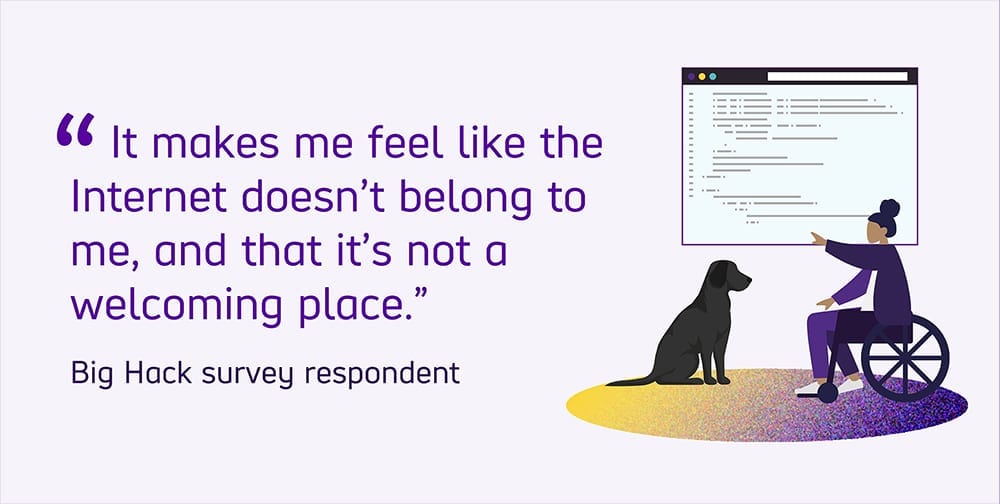We gather feedback from disabled people about their experiences online. Our survey is designed to assess the current state of web accessibility and see where companies are letting people down.
So, what did we find when we asked disabled users ‘How does it make you feel when you cannot complete a task online?’
Inaccessible websites leave disabled consumers “frustrated”

More than half of all responses, to date, have mentioned ‘frustrated’ ‘frustrating’ or ‘frustration’.
These responses, presented in the form of a word cloud, help us understand the dominant feelings attributed to inaccessibility. But such a large number of people responded with ‘frustrated’ that during development, it caused our word cloud to break. Several times.

This may seem obvious. Anyone who struggles to complete a task because of poor design will inevitably feel frustrated. But the stakes are higher for disabled people who rely on technology to live independently.
The real cost of ignoring web accessibility
Survey respondents said it makes them feel “annoyed” “anxious” “stressed” and “deflated” when they cannot complete a task online due to inaccessible websites and services.
Simple tasks like online shopping, banking and booking cinema tickets leave people feeling “upset” “angry” and “stupid”. One response simply said “Isolated. Excluded. Alone. Frustrated. Unimportant to society.”
Badly-designed websites make disabled customers feel like they are the problem
Responses reveal that inaccessible websites make disabled people feel like it’s their fault for not being able to use them.
“It makes me feel frustrated and angry with my body. It lowers my confidence, making me feel less independent.”

“It makes me feel annoyed at myself that I can’t do it.”
“Very frustrated as it means I’m forced to go out to get what I need to buy.”
Inaccessible websites can make people feel “more disabled”
Other feedback suggests online accessibility barriers can actually make people feel more disabled. Especially when it denies them of their independence.
“It makes me feel blind. Most of the time I go along not noticing my disability.”
“Frustrated. Because it makes me feel disabled and useless.”

“It makes me feel like I’m not independent and that I’m helpless. It makes me feel like I’m adhering to the stereotypical conventions of blind people.”
“When I can’t access a website … I despair because I have to rely on one of my friends for their working eyes to help me out. It strips me of my independence.”
Online accessibility feedback from our survey
Access to online services is vital with the physical world full of barriers
With a built environment full of physical barriers, having access to online services is even more critical. Often, disabled people are more reliant on digital access than non-disabled people.
Take wheelchair users, for example, people who are blind or have mobility impairments. Getting to the shops is either impossible or requires enormous effort. It often involves extra costs too, such as paying for public transport or private taxis.
It’s not about my feelings. It’s about the resume I couldn’t submit, or the place I couldn’t buy from, or the protest I couldn’t attend. I can manage my feelings, I can’t manage to use the world.
Survey respondent
Take an example of a blind person trying to order an item online. They cannot do so because the website is incompatible with a screen reader. They are forced to go to a physical shop to buy the item instead. Or they must abandon the purchase entirely or ask someone to help. None of these outcomes reflects an equal customer experience to that of a non-disabled person.
The social model of disability recognises that people are disabled by barriers (physical or prejudicial) in society. Not by their impairment or difference. Businesses can help by recognising these barriers, and that they make life harder for disabled people.
Disabled people can experience barriers in person (like a building without a ramp) as well as online (like an inaccessible website). When the physical world fails them, digital access is the only option. When neither work, the message they receive is that they are not worthy of consideration.
Removing online barriers through accessibility
Recognising and removing these barriers is a step towards equality. Web accessibility is one way of giving people more independence, choice and control.
If you already have a website, an accessibility audit can highlight these potential barriers. If you are developing a new website, consider accessibility at the start of the development process. It allows you to cater the customers who may rely on your services the most.
In both cases, ask yourself ‘Who are we designing this website for?’
Is it your stakeholders, upper management or internal staff? The answer should always be your customers.
And if your online services leave them feeling “frustrated” “annoyed” and “excluded,” you are adding to their problems.